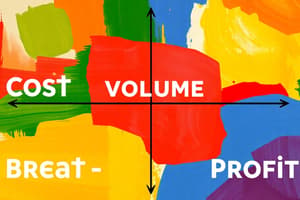Podcast
Questions and Answers
What does the break-even point represent?
What does the break-even point represent?
- The level of sales that guarantees a positive operating income
- The level of sales at which the company generates zero profits (correct)
- The level of sales at which total variable costs exceed total sales
- The level of sales at which the company maximizes profits
The margin of safety indicates how much current sales can fall before reaching the break-even point.
The margin of safety indicates how much current sales can fall before reaching the break-even point.
True (A)
What two elements comprise the total costs of a company?
What two elements comprise the total costs of a company?
Variable costs and fixed costs
The degree of operating leverage measures the impact of a percentage change in sales on the company's ________ income.
The degree of operating leverage measures the impact of a percentage change in sales on the company's ________ income.
Which of the following statements about variable costs is true?
Which of the following statements about variable costs is true?
Match the following concepts with their definitions:
Match the following concepts with their definitions:
In multiproduct companies, the sales mix is assumed to be variable.
In multiproduct companies, the sales mix is assumed to be variable.
What is the purpose of cost-volume-profit (CVP) analysis?
What is the purpose of cost-volume-profit (CVP) analysis?
What is the formula used to calculate profit in the contribution margin method?
What is the formula used to calculate profit in the contribution margin method?
The break-even point occurs when the company's profit is greater than zero.
The break-even point occurs when the company's profit is greater than zero.
If fixed expenses are $80,000 and the unit contribution margin (CM) is $20, how many units must be sold to break even?
If fixed expenses are $80,000 and the unit contribution margin (CM) is $20, how many units must be sold to break even?
To determine the margin of safety, subtract the break-even sales from the _______ sales.
To determine the margin of safety, subtract the break-even sales from the _______ sales.
Match the type of cost with its description:
Match the type of cost with its description:
What happens to operating income if variable costs increase while sales revenue also increases?
What happens to operating income if variable costs increase while sales revenue also increases?
A decrease in fixed expenses contributes positively to net operating income.
A decrease in fixed expenses contributes positively to net operating income.
Define contribution margin.
Define contribution margin.
What was the operating income for June when current sales were based on 500 units?
What was the operating income for June when current sales were based on 500 units?
An increase in fixed costs always leads to a decrease in operating income.
An increase in fixed costs always leads to a decrease in operating income.
By how much did the contribution margin increase when sales volume rose from 500 to 580 units?
By how much did the contribution margin increase when sales volume rose from 500 to 580 units?
An increase in advertising expenses resulted in a decrease in ________ by $2,000.
An increase in advertising expenses resulted in a decrease in ________ by $2,000.
What is the variable cost per unit when the variable costs increased by $10 and unit sales rose to 580?
What is the variable cost per unit when the variable costs increased by $10 and unit sales rose to 580?
Match the following terms with their definitions:
Match the following terms with their definitions:
Sales increased by $40,000 from selling 500 units to selling 580 units.
Sales increased by $40,000 from selling 500 units to selling 580 units.
When sales increased, fixed expenses remained ________.
When sales increased, fixed expenses remained ________.
Flashcards
Contribution Margin (CM)
Contribution Margin (CM)
Difference between sales revenue and variable expenses, used for covering fixed costs and generating profit.
Fixed Expenses
Fixed Expenses
Costs that do not change with the volume of production or sales.
Variable Expenses
Variable Expenses
Costs that change in direct proportion to the volume of production or sales.
Break-Even Point (BEP)
Break-Even Point (BEP)
Signup and view all the flashcards
Break-Even Point in Units
Break-Even Point in Units
Signup and view all the flashcards
Contribution Margin Ratio
Contribution Margin Ratio
Signup and view all the flashcards
CVP Analysis
CVP Analysis
Signup and view all the flashcards
Unit CM
Unit CM
Signup and view all the flashcards
Cost-Volume-Profit (CVP) Analysis
Cost-Volume-Profit (CVP) Analysis
Signup and view all the flashcards
Variable Costs
Variable Costs
Signup and view all the flashcards
Fixed Costs
Fixed Costs
Signup and view all the flashcards
Break-Even Point
Break-Even Point
Signup and view all the flashcards
Margin of Safety
Margin of Safety
Signup and view all the flashcards
Sales Mix
Sales Mix
Signup and view all the flashcards
Degree of Operating Leverage
Degree of Operating Leverage
Signup and view all the flashcards
Impact of Fixed Cost Increase
Impact of Fixed Cost Increase
Signup and view all the flashcards
Contribution Margin (CM) Analysis
Contribution Margin (CM) Analysis
Signup and view all the flashcards
How does increased variable costs per unit affect profit?
How does increased variable costs per unit affect profit?
Signup and view all the flashcards
Impact of Variable Cost Increase with Sales Increase
Impact of Variable Cost Increase with Sales Increase
Signup and view all the flashcards
Example Company's Sales Increase
Example Company's Sales Increase
Signup and view all the flashcards
Example Company's Variable Cost Increase
Example Company's Variable Cost Increase
Signup and view all the flashcards
Operating Income
Operating Income
Signup and view all the flashcards
Contribution Margin (CM) Formula
Contribution Margin (CM) Formula
Signup and view all the flashcards
Study Notes
Chapter 4: Cost-Volume-Profit Relationships
- Cost-volume-profit (CVP) analysis is a powerful tool used by managers to understand the relationship between cost, volume, and profit. It focuses on the interplay of five key elements: product prices, activity level, per-unit variable costs, total fixed costs, and product mix.
Learning Objectives Part 1
- Explain how changes in activity affect contribution margin and operating income.
- Prepare and interpret a cost-volume-profit graph.
- Calculate the contribution margin ratio and variable expense ratio. Use the contribution margin ratio to calculate changes in contribution margin and operating income resulting from changes in sales volume.
- Show the effects on contribution margin of changes in variable costs, fixed costs, selling price, and volume.
Learning Objectives Part 2
- Compute the break-even point in unit sales and sales dollars.
- Determine the level of sales needed to achieve a desired target profit.
- Compute the margin of safety and explain its significance.
- Explain cost structure, compute the degree of operating leverage at a particular sales level, and explain how operating leverage can be used to predict changes in operating income.
Learning Objectives Part 3
- Compute the break-even point for a multi-product company and explain the effect of changes in sales mix on contribution margin and the break-even point.
- Conduct a cost-volume-profit analysis with uncertainty (Online Appendix 4A).
Cost-Volume-Profit Relationship Interactions
- CVP analysis helps managers understand the interaction between cost, volume, and profit.
- The key elements are product prices, activity level, per-unit variable costs, total fixed costs, and product mix.
Basics of Cost-Volume-Profit Analysis
- The contribution income statement helps managers assess the impact of changes in selling price, cost, or volume on profits.
- Contribution margin (CM) is the amount remaining from sales revenue after variable expenses are deducted.
Contribution Margin (CM)
- Sales, variable expenses, and contribution margin can be expressed on a per-unit basis.
- If an additional unit is sold, $200 additional CM would be generated.
Contribution Margin Ratio
-
The contribution margin ratio is calculated by dividing the total contribution margin by total sales.
- CM ratio = Total contribution margin / total sales
-
For Example Company, the ratio is 40%.
-
Each $1.00 increase in sales results in a $0.40 increase in total contribution margin.
The Contribution Approach
- Each month, $80,000 in total contribution margin must be generated to break even.
- Any additional contribution margin becomes operating income.
The Contribution Approach 2
- If 400 units are sold, the company is operating at the break-even point.
The Contribution Approach 3
- Selling one more unit beyond the break-even point increases net operating income by $200.
The Contribution Approach 4
- It is not necessary to prepare an income statement for every sales level.
- Simply multiply the number of units sold above break-even by the contribution margin per unit to estimate profits at different sales levels.
CVP Relationships in Graphic Form
- Relationships among revenue, cost, profit, and volume can be expressed graphically using a Cost-Volume-Profit graph.
CVP Graph 1
- In a CVP graph, unit volume is shown on the horizontal (X) axis and dollars are shown on the vertical (Y) axis.
CVP Graph 2
- A CVP graph shows total sales, total expenses, and fixed expenses.
CVP Graph 3
- The CVP graph shows the break-even point, profit area, and the loss area.
Contribution Margin Ratio 1
- The contribution margin ratio is calculated by dividing the total contribution margin by the total sales.
- For Example Company, the ratio is 40%
Contribution Margin Ratio 2
- In terms of units, the contribution margin ratio is the unit contribution margin divided by the unit selling price.
- Example Company's ratio is 40%
Contribution Margin Ratio 3
- A $50,000 increase in sales leads to a $20,000 increase in contribution margin. [The formula is: (Change in CM) = (CM ratio) x (Change in Sales)]
Contribution Margin Ratio 4
- Changes in sales revenue can be calculated using the formula (Change in CM) = (CM Ratio) x (Change in Sales)
Quick Check (Example Questions)
- Questions focusing on calculating CM ratios, break-even points, and margins of safety.
Break-Even Analysis 1
- Break-even analysis is a way to determine if a company will lose money or make a profit at varying sales levels.
Break-Even Analysis 2
- The contribution format income statement can be expressed mathematically in equation form.
- Profit = (Sales - Variable Expenses) - Fixed Expenses
Break-Even Analysis 3
- The above formula can be simplified to Profit = (Contribution Margin x Units Sold) - Fixed Expenses
Break-Even Analysis 4
- Break-even units sold = (Fixed Expenses) / (Unit CM)
- Break-even sales in dollars = (Fixed Expenses) / (CM ratio)
Break-Even Analysis 5
- Example Company's income statement at 500 units shows operating income of $20,000,
- Calculating break-even point in units and dollars using provided data for the company.
Break-Even Analysis 6
- Break-even point (units) = (Fixed Expenses) / (Unit CM)
- Break-even point (dollars) = (Fixed Expenses) / (CM Ratio)
Target Operating Profit Analysis 1
- CVP formulas can determine the sales volume or dollars needed to achieve a target operating profit.
- Assume that Example Company wants to earn a profit of $100,000 by knowing the unit sales needed.
Target Operating Profit Analysis 2
- Calculating the number of units needed to be sold to achieve a target operating profit.
- [Units to achieve target profit] = [Fixed Costs + Target Profit] / [Unit Contribution Margin]
Target Operating Profit Analysis 3
- Calculating target sales dollars to achieve a target profit using the formula [Target Sales Dollars] = [Fixed Costs + Target Profit]/[CM Ratio]
After-Tax Analysis 1
- For-profit companies pay corporate income tax on profits.
- In general, operating profit after tax can be computed as a fixed percentage of income before tax.
After-Tax Analysis 2
- Profit after tax = Before tax profit – Tax.
- Before tax profit = Profit after tax / (1 − tax rate)
The Margin of Safety 1
- Margin of safety is the excess of budgeted (or actual) sales over the break-even sales.
- Margin of safety = Total sales – Break-even sales.
The Margin of Safety 2
- Margin of safety percentage = Margin of safety / Total sales
The Margin of Safety 3
- Expressing margin of safety as a percentage from the relationship ($50,000 / $250,000 = 20%)
The Margin of Safety 4
- Determining margin of safety in terms of units sold, given a sales price per unit and total margin of safety in dollars
Cost Structure and Profit Stability 1
- Cost structure refers to the proportion of fixed and variable costs.
- Managers have choices in determining cost structure.
Cost Structure and Profit Stability 2
- High fixed costs lead to higher income in good years but lower in bad years.
- Low fixed costs lead to more income stability in good and bad years.
Operating Leverage 1
- Operating leverage measures the sensitivity of net operating income to percentage changes in sales.
- Degree of operating leverage = Contribution Margin / Operating Income
- % change in operating income = Degree of operating leverage x % change in sales
Operating Leverage 2
- Example calculation of operating leverage for Example Company. [Example: $100,000 (Operating income) / $20,000 (Net operating income)= 5 ]
Operating Leverage 3
- If sales increase by 10%, net operating income will increase by 50% (at 5 times operating leverage).
Operating Leverage 4
- Showing the impact of a sales increase on the net operating income. For 10% increase in sales, Net Operating Income increases by 50% (at 5 times operating leverage).
Assumptions of CVP Analysis
- Selling prices are constant.
- Costs are linear.
- Variable costs per unit are constant.
- Fixed costs are constant in total.
- Sales mix is constant.
- In manufacturing companies, inventories do not change.
End of Chapter Summary Part 1
- Cost-volume-profit (CVP) analysis is based on a simple model of how contribution margin (CM) and operating income respond to changes in selling prices, costs, and volume.
- A CVP graph graphically displays the relationships between sales volume in units and fixed/variable expenses, total expenses, total sales, and profits.
End of Chapter Summary Part 2
- The CM ratio (contribution margin ratio) is used to estimate the effect of a change in total sales on operating income.
- The break-even point is the level of sales at which zero profits occur.
- The margin of safety is the amount by which current sales exceed break-even sales.
End of Chapter Summary Part 3
- The degree of operating leverage measures how much a percentage change in sales affects the company's operating income.
- Companies with a higher degree of operating leverage are more sensitive to sales changes.
- Profits of multiproduct companies are influenced by their sales mix.
Cost-Volume-Profit Analysis with Uncertainty (Appendix 4A)
- Cost-volume-profit analysis is used to assess future possibilities under various alternatives and management can use data for various alternatives and relevant decision trees in the analysis.
- Subjective probabilities can be used to model what a manager believes will occur, determining the probability for different possible alternatives.
- This information can be used to estimate expected future profits.
Studying That Suits You
Use AI to generate personalized quizzes and flashcards to suit your learning preferences.



